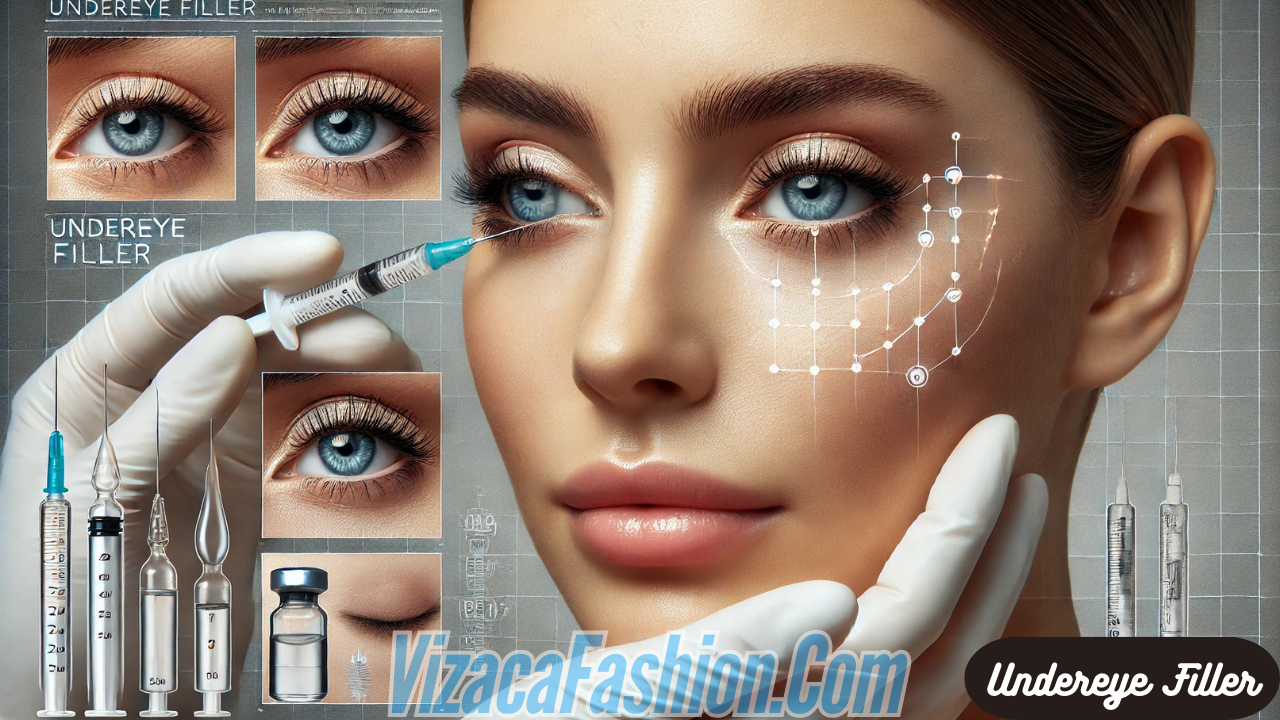Introduction: What is Undereye Filler?
Undereye fillers are a popular cosmetic treatment used to reduce the appearance of dark circles, hollowness, and fine lines under the eyes. This non-surgical procedure involves the injection of dermal fillers into the under-eye area to restore volume, smoothen the skin, and create a more youthful and refreshed appearance. Over time, as we age, the skin under our eyes loses fat and collagen, which can lead to sunken or tired-looking eyes. Undereye fillers offer a solution for individuals seeking to rejuvenate their eye area without the need for invasive surgery.
In this article, we will delve into the details of undereye fillers, covering the benefits, types of fillers, the procedure, and essential aftercare tips.
Why Choose Undereye Filler?
The delicate under-eye area can be one of the first places to show signs of aging. Factors such as genetics, lifestyle choices, and environmental influences contribute to the appearance of tired eyes. Undereye fillers help restore the lost volume and fill in hollows, which can improve the overall aesthetic of the face. Let’s explore the key benefits of undereye filler treatment.
1. Reduces Dark Circles and Shadows
One of the primary reasons people opt for undereye fillers is to diminish the appearance of dark circles. Dark circles occur when the skin under the eyes becomes thin or sunken, allowing blood vessels to become more visible. By adding volume to this area, fillers help to reduce the shadowing effect, making the under-eye region appear brighter and more awake.
2. Restores Volume and Fills in Hollow Areas
As we age, we lose fat and collagen beneath the skin, especially around the under-eye area. This can cause a hollow or sunken appearance, which can make individuals look older or fatigued. Undereye fillers help to replenish lost volume and restore the youthful fullness to the under-eye region.
3. Minimizes Fine Lines and Wrinkles
With age, fine lines and wrinkles can develop around the eyes, making us appear older than we feel. Undereye fillers help to smooth out these lines by plumping up the skin and promoting a more youthful appearance. This can lead to an overall refreshed look without the need for invasive surgery.
4. Non-Surgical Alternative
Unlike surgical options, such as blepharoplasty (eyelid surgery), undereye fillers are a non-invasive solution. The procedure is quick, minimally painful, and requires little to no downtime. For those who want to avoid the risks and recovery time associated with surgery, undereye fillers present an excellent alternative.
Types of Undereye Fillers
There are several types of dermal fillers used for the under-eye area, and the choice of filler depends on the individual’s specific needs and the expertise of the practitioner. The most common types of fillers used in undereye treatments include:
1. Hyaluronic Acid (HA) Fillers
Hyaluronic acid fillers, such as Restylane and Juvederm, are the most commonly used fillers for undereye treatments. HA is a naturally occurring substance in the body that helps retain moisture and add volume to the skin. These fillers are known for their safety, effectiveness, and ability to provide natural-looking results. HA fillers are reversible, meaning if the patient is not satisfied with the results, the filler can be dissolved.
2. Calcium Hydroxylapatite (CaHA) Fillers
Calcium hydroxylapatite fillers, such as Radiesse, are another option for undereye treatments. These fillers are more durable than HA fillers and can provide longer-lasting results. However, they may not be as easily reversible as HA fillers. CaHA fillers also stimulate collagen production in the skin, which can help improve the overall skin quality over time.
3. Poly-L-Lactic Acid Fillers
Poly-L-lactic acid fillers, such as Sculptra, work by stimulating collagen production beneath the skin. These fillers are typically used for more significant volume loss or to address deeper lines and wrinkles. They require several treatments to achieve optimal results, and the effects develop gradually over time.
The Undereye Filler Procedure
The undereye filler procedure is relatively quick and straightforward. Here’s what you can expect during the treatment:
1. Consultation
Before undergoing the procedure, you’ll have a consultation with a board-certified injector. During this session, the injector will assess your under-eye area, discuss your goals, and recommend the most suitable type of filler for your needs. They will also explain the risks and benefits of the treatment and answer any questions you may have.
2. Numbing the Area
To ensure a comfortable experience, a topical numbing cream will be applied to the under-eye area before the filler injections. This helps minimize any discomfort during the procedure. Some fillers also contain lidocaine, a local anesthetic, to further reduce pain.
3. Injection
Once the area is numbed, the filler is carefully injected into the targeted area using a very fine needle. The injector will strategically place the filler to restore volume, reduce shadows, and smooth out wrinkles. The procedure typically takes about 15 to 30 minutes, depending on the extent of the treatment.
4. Post-Treatment Care
After the procedure, you may experience mild swelling, redness, or bruising at the injection sites. These side effects are temporary and typically resolve within a few days. You will be given aftercare instructions to follow, which may include avoiding strenuous activities, excessive heat, and direct sun exposure for a short period.
Aftercare Tips for Undereye Fillers
To ensure the best results and minimize any potential side effects, it’s important to follow proper aftercare instructions. Here are some helpful tips for post-treatment care:
1. Apply Ice Packs
To reduce swelling and bruising, you can apply ice packs to the under-eye area for short intervals after the treatment. Be sure to wrap the ice in a clean cloth to avoid direct contact with the skin.
2. Avoid Touching the Area
It’s important to avoid rubbing or massaging the treated area for at least 24 hours after the procedure. This helps prevent the filler from shifting out of place and allows it to settle properly.
3. Skip Strenuous Activities
For the first 24 to 48 hours, refrain from engaging in intense physical activities, such as exercise or hot yoga. Excessive movement or heat can increase swelling and may affect the final results of the filler treatment.
4. Protect Your Skin from the Sun
Be sure to wear sunscreen to protect the delicate skin around your eyes from UV damage. The skin in this area is thin and sensitive, so sun protection is essential for maintaining long-term results.
Potential Risks and Side Effects
While undereye fillers are generally safe, there are some potential risks and side effects associated with the treatment. These include:
- Bruising and Swelling: Mild swelling and bruising are common after the procedure but usually resolve within a few days.
- Lumps or Bumps: In some cases, small lumps may form under the skin, but these typically smooth out on their own within a few weeks.
- Infection: As with any injection, there is a slight risk of infection, but this can be minimized by ensuring the procedure is performed in a sterile environment.
- Allergic Reactions: Although rare, some individuals may experience an allergic reaction to the filler material. It’s important to discuss any allergies with your provider before the treatment.
How Long Do Results Last?
The results of undereye fillers can last anywhere from six months to a year, depending on the type of filler used, the amount of product injected, and individual factors such as metabolism and lifestyle. Over time, the filler will naturally be absorbed by the body, and maintenance treatments may be required to sustain the results.
Conclusion: Is Undereye Filler Right for You?
Undereye fillers are a safe and effective way to address common concerns such as dark circles, hollowness, and fine lines under the eyes. This non-surgical procedure offers a quick solution for those looking to rejuvenate their appearance and restore a more youthful and refreshed look. If you’re considering undereye fillers, it’s essential to consult with a qualified professional who can help determine the best treatment plan based on your needs and goals.
By understanding the procedure, benefits, and aftercare tips, you can make an informed decision about whether undereye fillers are right for you.


